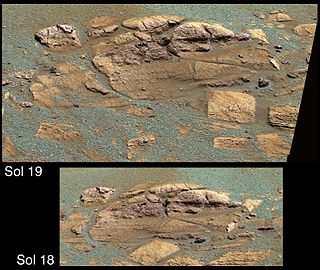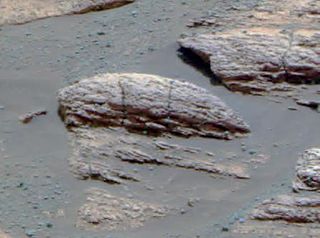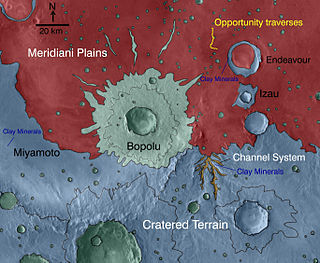
Beer is a crater lying situated within the Margaritifer Sinus quadrangle (MC-19) region of the planet Mars, named in honor of the German astronomer, Wilhelm Beer. It is located at 14.4°S 351.8°E.
Mädler is a crater on Mars named in honor of the German astronomer Johann Heinrich Mädler. It is located at 2.7°E 10.7°S.

Sinus Meridiani is an albedo feature on Mars stretching east-west just south of that planet's equator. It was named by the French astronomer Camille Flammarion in the late 1870s.
Crewe is a crater approximately 3 km in diameter lying situated within the Margaritifer Sinus quadrangle (MC-19) region of the planet Mars, located at 25° South, 10° West.

Erebus is a crater lying situated within the Margaritifer Sinus quadrangle (MC-19) region of the planet Mars, this extraterrestrial geological feature was visited by the Opportunity rover on the way to the much larger crater Victoria. It is named after the polar exploration vessel HMS Erebus which was used by James Clark Ross in 1841 to discover the Great Ice Barrier, now known as the Ross Ice Shelf. The rover was in the immediate vicinity of the crater from approximately sol 550 to 750.

Holden is a 140 km wide crater situated within the Margaritifer Sinus quadrangle (MC-19) region of the planet Mars, located with the southern highlands. It is named after American astronomer Edward Singleton Holden. It is part of the Uzboi-Landon-Morava (ULM) system.

Uzboi Vallis is a valley lying situated within the Margaritifer Sinus quadrangle (MC-19) region on Mars. It is named after the Uzboy dry channel, now in Turkmenistan, which repeatedly served as the main channel of the Amu Darya river. The valley begins on the northern rim of the Argyre basin, and cuts through several craters, before ending at Holden crater.

Emma Dean is a small impact crater in the Meridiani Planum extraterrestrial plain situated within the Margaritifer Sinus quadrangle (MC-19) region of the planet Mars. This geological feature was visited by the Opportunity rover from sols 929 to 943. The much larger crater Victoria lies about 100m to the east. Emma Dean lies directly on top of the ejecta blanket from Victoria and could therefore expose material originating from deep inside Victoria. The crater is named after Emma Dean, John Wesley Powell's wife and one of the boats in Grand Canyon Powell expedition.

Cape Verde is a large promontory and extremity on the rim of Victoria Crater in Meridiani Planum, an extraterrestrial plain within the Margaritifer Sinus quadrangle (MC-19) region of the planet Mars. The Mars Exploration Rover Opportunity perched atop this feature in 2006 to take a true-color mosaic of the crater below. Sols 958 to 991 were spent on this cape, including the period of solar conjunction which spanned from sol 970 to sol 984.

El Capitan is a layered rock outcrop found within the Margaritifer Sinus quadrangle (MC-19) region of the planet Mars, this geological outcrop was first discovered and observed by the Mars Exploration Rover Opportunity in February 2004. The rock outcrop was named for El Capitan, a topographical mountain lying within the state, Texas.

Last Chance is a layered rock outcrop found within the Margaritifer Sinus quadrangle (MC-19) region of the planet Mars, discovered by the Mars Exploration Rover Opportunity in March 2004. The rock lies within the outcrop near the rover's landing site at Meridiani Planum, Mars.

Iani Chaos is a region of chaos terrain at the south end of the outflow channel Ares Vallis, of the Margaritifer Sinus quadrangle (MC-19) region of the planet Mars, centered at approximately ~342°E, 2°S. This is the source region of Ares Vallis. The chaotic terrain is widely believed to have formed via the removal of subsurface water or ice, resulting in flooding at the surface, and the formation of Ares Vallis. Within Iani Chaos, deposited stratigraphically above the chaotic terrain, are smooth, low-slope, intermediate-to-light-toned deposits that are rich in a hydrated mineral that is most likely gypsum as well as hematite.

Verde Vallis is an ancient river valley in the Sinus Sabaeus quadrangle on Mars. It is found in the Sinus Sabaeus quadrangle at 0.5° south latitude and 330.2° west longitude. It is named after a river in Arizona, USA.

Nirgal Vallis is a long river channel bordering the Coprates quadrangle and Margaritifer Sinus quadrangle of Mars at 28.4° south latitude and 42° west longitude. It is 610 km long and is named after the word for "Mars" the god of war in Babylonian. Nirgal Vallis had a discharge of 4800 cubic meters/second. The western half of Nirgal Valles is a branched system, but the eastern half is a tightly sinuous, deeply entrenched valley. Nirgal Valles ends at Uzboi Vallis. Tributaries are very short and end in steep-walled valley heads, often called "amphitheater-headed valleys." The shape of these valley heads is like cirques on the Earth.

Pollack is an impact crater in the Sinus Sabaeus quadrangle of Mars, located at 7.9° S and 334.8° W. It measures 96 kilometers in diameter and was named after James B. Pollack, an American astrophysicist (1938–1994). Pollack Crater contains a large light toned deposit that was once thought to be a salt deposit. However, the surrounding rocks are exceptionally dark and that makes this deposit appear white.

Timbuktu is an old crater on Mars, located in the Margaritifer Sinus quadrangle (MC-19) region at 5.7° S and 37.6° W. It measures approximately 66 kilometers in diameter and was named after the ancient city of Timbuktu in Mali, Africa.

Iazu is an impact crater located within the Meridiani Planum extraterrestrial plain, situated within the Margaritifer Sinus quadrangle (MC-19) region of the planet Mars. This geological feature is about 7 km in diameter. It is close to the landing site of the Mars Exploration Rover-B Opportunity, and its walls have been photographed by the spacecraft during its traverse to Endeavour Crater. At the time, the crater was about 38 kilometers (24 mi) away. It was named in 2006 for Iazu, a commune in Dâmboviţa County, southern Romania.

Jones is an impact crater on Mars, located at 19.1°S 19.9°W in the Margaritifer Sinus quadrangle. It measures 94.0 kilometer in diameter and was named after English astronomer Harold Spencer Jones (1890–1960). The name was approved in 1973, by the International Astronomical Union (IAU) Working Group for Planetary System Nomenclature (WGPSN).

Vinogradov is an impact crater in the Margaritifer Sinus quadrangle of Mars, located at 20.2°S°S latitude and 37.7°W°W longitude. It measures 223.5 km in diameter and was named after Alexander Pavlovich Vinogradov, and the name was approved in 1979 by the International Astronomical Union (IAU) Working Group for Planetary System Nomenclature (WGPSN).
The Uzboi-Landon-Morava (ULM) outflow system is a long series of channels and depressions that may have carried water across a major part of Mars. It starts with channels that drain into the Argyre basin in the Argyre quadrangle. Water ponded in the Argyre basin, then the overflow is believed to have traveled northward through Uzboi Vallis, into Landon basin, through Morava Valles, to the floor of Margaritfier basin. Some of the water may have helped to carve Ares Vallis. Altogether, the total area drained for this watershed may have been about 11 X 106 km2 or about 9% of Mars.




















